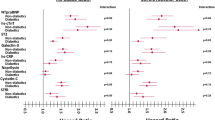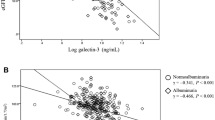Abstract
Purpose
Plasma galectin-3 (pG3) regulates inflammation. B-type natriuretic peptide (BNP), high-sensitivity Troponin I (hsTnI), and pG3 concentrations are elevated in chronic kidney disease (CKD) patients. The associations of pG3 with hsTnI/BNP are unclear. We explored the relationship of hsTnI and BNP with pG3 in Asian CKD patients and healthy controls.
Methods
We retrieved prospectively collected frozen plasma samples from 163 stable CKD patients and 105 healthy controls. BNP, hsTnI and pG3 were assayed. pG3 was assessed for associations with age, gender, ethnicity, blood pressures; height, weight, body mass index (BMI), previously diagnosed CKD, diabetes, hypertension, coronary artery disease, estimated glomerular filtration rate (eGFR); C-reactive protein, beta-trace protein, 24 h urine protein, serum albumin, uric acid and cystatin C. We created two models predicting pG3 using multiple linear regression. Akaike Information Criterion (AIC) was used for comparison. Significance was taken at P < 0.05.
Results
CKD versus healthy participants: mean BMI (28.2 vs. 24.9 kg/m2), median serum creatinine (159 vs. 69 µmol/L; 1.8 vs. 0.78 mg/dL), median eGFR (49 vs. 104 mL/min/1.73m2), median pG3 (29.4 vs. 15.4 ng/mL), median BNP (136 vs. 23 pg/mL), and median hsTnI (12.5 vs. 2.6 pg/mL). By univariate analysis, all variables are associated with pG3 except weight, gender and diagnosis of cerebrovascular or peripheral vascular diseases. A parsimonious model selected for hsTnI, BMI, serum albumin, cystatin C and eGFR (AIC = 77.6).
Conclusion
BNP and hsTnI are associated with pG3 in Asian CKD patients. hsTnI is a better predictor of pG3.
Similar content being viewed by others
References
Chen SC, Kuo PL (2016) The Role of galectin-3 in the kidneys. Int J Mol Sci 17:565
Davidson PJ, Davis MJ, Patterson RJ, Ripoche MA, Poirier F, Wang JL (2002) Shuttling of galectin-3 between the nucleus and cytoplasm. Glycobiology 12:329–337
Desmedt V, Desmedt S, Delanghe JR, Speeckaert R, Speeckaert MM (2016) Galectin-3 in renal pathology: more than just an innocent bystander. Am J Nephrol 43:305–317
Hsu DK, Liu FT (2004) Regulation of cellular homeostasis by galectins. Glycoconj J 19:507–515
de Boer RA, Voors AA, Muntendam P, van Gilst WH, van Veldhuisen DJ (2009) Galectin-3: a novel mediator of heart failure development and progression. Eur J Heart Fail 11:811–817
Henderson NC, Sethi T (2009) The regulation of inflammation by galectin-3. Immunol Rev 230:160–171
Straube T, Elli AF, Greb C, Hegele A, Elsasser HP, Delacour D et al (2011) Changes in the expression and subcellular distribution of galectin-3 in clear cell renal cell carcinoma. J Exp Clin Cancer Res 30:89
Henderson NC, Mackinnon AC, Farnworth SL, Kipari T, Haslett C, Iredale JP et al (2008) Galectin-3 expression and secretion links macrophages to the promotion of renal fibrosis. Am J Pathol 172:288–298
Okamura DM, Pasichnyk K, Lopez-Guisa JM, Collins S, Hsu DK, Liu FT et al (2011) Galectin-3 preserves renal tubules and modulates extracellular matrix remodeling in progressive fibrosis. Am J Physiol Renal Physiol 300:F245–F253
Prud'homme M, Coutrot M, Michel T, Boutin L, Genest M, Poirier F et al (2019) Acute kidney injury induces remote cardiac damage and dysfunction through the galectin-3 pathway. JACC Basic Transl Sci 4:717–732
Calvier L, Miana M, Reboul P, Cachofeiro V, Martinez-Martinez E, de Boer RA et al (2013) Galectin-3 mediates aldosterone-induced vascular fibrosis. Arterioscler Thromb Vasc Biol 33:67–75
Sharma UC, Pokharel S, van Brakel TJ, van Berlo JH, Cleutjens JP, Schroen B et al (2004) Galectin-3 marks activated macrophages in failure-prone hypertrophied hearts and contributes to cardiac dysfunction. Circulation 110:3121–3128
Vergaro G, Prud'homme M, Fazal L, Merval R, Passino C, Emdin M et al (2016) Inhibition of galectin-3 pathway prevents isoproterenol-induced left ventricular dysfunction and fibrosis in mice. Hypertension 67:606–612
Yu L, Ruifrok WP, Meissner M, Bos EM, van Goor H, Sanjabi B et al (2013) Genetic and pharmacological inhibition of galectin-3 prevents cardiac remodeling by interfering with myocardial fibrogenesis. Circ Heart Fail 6:107–117
Tang WH, Shrestha K, Shao Z, Borowski AG, Troughton RW, Thomas JD et al (2011) Usefulness of plasma galectin-3 levels in systolic heart failure to predict renal insufficiency and survival. Am J Cardiol 108:385–390
Lok DJ, Van Der Meer P, de la Porte PW, Lipsic E, Van Wijngaarden J, Hillege HL et al (2010) Prognostic value of galectin-3, a novel marker of fibrosis, in patients with chronic heart failure: data from the DEAL-HF study. Clin Res Cardiol 99:323–328
Zamora E, Lupon J, de Antonio M, Galan A, Domingo M, Urrutia A et al (2014) Renal function largely influences Galectin-3 prognostic value in heart failure. Int J Cardiol 177:171–177
Gopal DM, Kommineni M, Ayalon N, Koelbl C, Ayalon R, Biolo A et al (2012) Relationship of plasma galectin-3 to renal function in patients with heart failure: effects of clinical status, pathophysiology of heart failure, and presence or absence of heart failure. J Am Heart Assoc 1:e000760
Drechsler C, Delgado G, Wanner C, Blouin K, Pilz S, Tomaschitz A et al (2015) Galectin-3, renal function, and clinical outcomes: results from the LURIC and 4D studies. J Am Soc Nephrol 26:2213–2221
Bansal N, Hyre Anderson A, Yang W, Christenson RH, deFilippi CR, Deo R et al (2015) High-sensitivity troponin T and N-terminal pro-B-type natriuretic peptide (NT-proBNP) and risk of incident heart failure in patients with CKD: the chronic renal insufficiency cohort (CRIC) study. J Am Soc Nephrol 26:946–956
Teo BW, Koh YY, Toh QC, Li J, Sinha AK, Shuter B et al (2014) Performance of the CKD-EPI creatinine-cystatin C glomerular filtration rate estimation equations in a multiethnic Asian population. Singapore Med J 55:656–659
Teo BW, Xu H, Koh YY, Li J, Subramanian S, Sinha AK et al (2014) Glomerular filtration rates in healthy Asians without kidney disease. Nephrology 19:72–79
Teo BW, Xu H, Wang D, Li J, Sinha AK, Shuter B et al (2011) GFR estimating equations in a multiethnic Asian population. Am J Kidney Dis 58:56–63
Alam ML, Katz R, Bellovich KA, Bhat ZY, Brosius FC, de Boer IH et al (2019) Soluble ST2 and Galectin-3 and Progression of CKD. Kidney Int Rep 4:103–111
Meijers WC, van der Velde AR, Ruifrok WP, Schroten NF, Dokter MM, Damman K et al (2014) Renal handling of galectin-3 in the general population, chronic heart failure, and hemodialysis. J Am Heart Assoc 3:e000962
Rebholz CM, Selvin E, Liang M, Ballantyne CM, Hoogeveen RC, Aguilar D et al (2018) Plasma galectin-3 levels are associated with the risk of incident chronic kidney disease. Kidney Int 93:252–259
Seliger SL, Hong SN, Christenson RH, Kronmal R, Daniels LB, Lima JAC et al (2017) High-sensitive cardiac troponin t as an early biochemical signature for clinical and subclinical heart Failure: MESA (multi-ethnic study of atherosclerosis). Circulation 135:1494–1505
Siciliano M, Mettimano M, Dondolini-Poli A, Ballarin S, Migneco A, Annese R et al (2000) Troponin I serum concentration: a new marker of left ventricular hypertrophy in patients with essential hypertension. Ital Heart J 1:532–535
Iliou MC, Fumeron C, Benoit MO, Tuppin P, Courvoisier CL, Calonge VM et al (2001) Factors associated with increased serum levels of cardiac troponins T and I in chronic haemodialysis patients: chronic haemodialysis and new cardiac markers evaluation (CHANCE) study. Nephrol Dial Transplant 16:1452–1458
Freda BJ, Tang WH, Van Lente F, Peacock WF, Francis GS (2002) Cardiac troponins in renal insufficiency: review and clinical implications. J Am Coll Cardiol 40:2065–2071
Mallamaci F, Zoccali C, Parlongo S, Tripepi G, Benedetto FA, Cutrupi S et al (2002) Troponin is related to left ventricular mass and predicts all-cause and cardiovascular mortality in hemodialysis patients. Am J Kidney Dis 40:68–75
deFilippi C, Wasserman S, Rosanio S, Tiblier E, Sperger H, Tocchi M et al (2003) Cardiac troponin T and C-reactive protein for predicting prognosis, coronary atherosclerosis, and cardiomyopathy in patients undergoing long-term hemodialysis. JAMA 290:353–359
Acknowledgements
This study was funded by the NUHS Clinician Scientist Program-Residency awarded to Dr Gek Cher Chan (2014). The Asian Kidney Disease Study and Singapore Kidney Function Study were funded in part by the National Medical Research Council (Blockvote), Ministry of Education Academic Research Fund Tier 1 (2008), and National Kidney Foundation Singapore (NKFRC/2011/07/21), by grants awarded to Dr Boon Wee Teo. Other members of the NUHS Nephrology Clinical Research Group who actively managed the databases and laboratory include Dr Hui Xu, Mr Qichun Toh, and Ms Sharon Saw.
Funding
This study was funded by the NUHS Clinician Scientist Program-Residency awarded to Dr Gek Cher Chan (2014). The Asian Kidney Disease Study and Singapore Kidney Function Study were funded in part by the National Medical Research Council (Blockvote), Ministry of Education Academic Research Fund Tier 1 (2008), and National Kidney Foundation Singapore (NKFRC/2011/07/21), by grants awarded to Dr Boon Wee Teo.
Author information
Authors and Affiliations
Contributions
Conceptualization: Gek Cher Chan, Jialiang Li, Boon Wee Teo; Methodology: Gek Cher Chan, Boon Wee Teo; Formal analysis and investigation: Gek Cher Chan, Peh Joo Ho, Jialiang Li, Boon Wee Teo; Writing–original draft preparation: Gek Cher Chan, Boon Wee Teo; Writing–review and editing: Gek Cher Chan, Peh Joo Ho, Jialiang Li, Evan Jon Choon Lee, Horng Ruey Chua, Titus Lau, Sunil Sethi, Boon Wee Teo; Fund acquisition: Gek Cher Chan, Boon Wee Teo; Resources: Evan Jon Choon Lee, Horng Ruey Chua, Titus Lau, Sunil Sethi, Boon Wee Teo; Supervision: Boon Wee Teo.
Corresponding author
Ethics declarations
Conflict of interest
The authors declare that they have no conflict of interest.
Ethical approval
The studies involving human participants were in accordance with the ethical standard of the institutional/national research committee (National Healthcare Group Domain Specific Review Board 2007/00225-SRF0004) and with the 1964 Helsinki declaration and its later amendments or comparable ethical standards.
Informed consent
Informed consent was obtained from all individual participants included in the study.
Additional information
Publisher's Note
Springer Nature remains neutral with regard to jurisdictional claims in published maps and institutional affiliations.
Electronic supplementary material
Below is the link to the electronic supplementary material.
Rights and permissions
About this article
Cite this article
Chan, G.C., Ho, P.J., Li, J. et al. High-sensitivity Troponin I Predicts Galectin-3 in Chronic Kidney Disease Patients. Int Urol Nephrol 52, 533–540 (2020). https://doi.org/10.1007/s11255-020-02390-5
Received:
Accepted:
Published:
Issue Date:
DOI: https://doi.org/10.1007/s11255-020-02390-5




